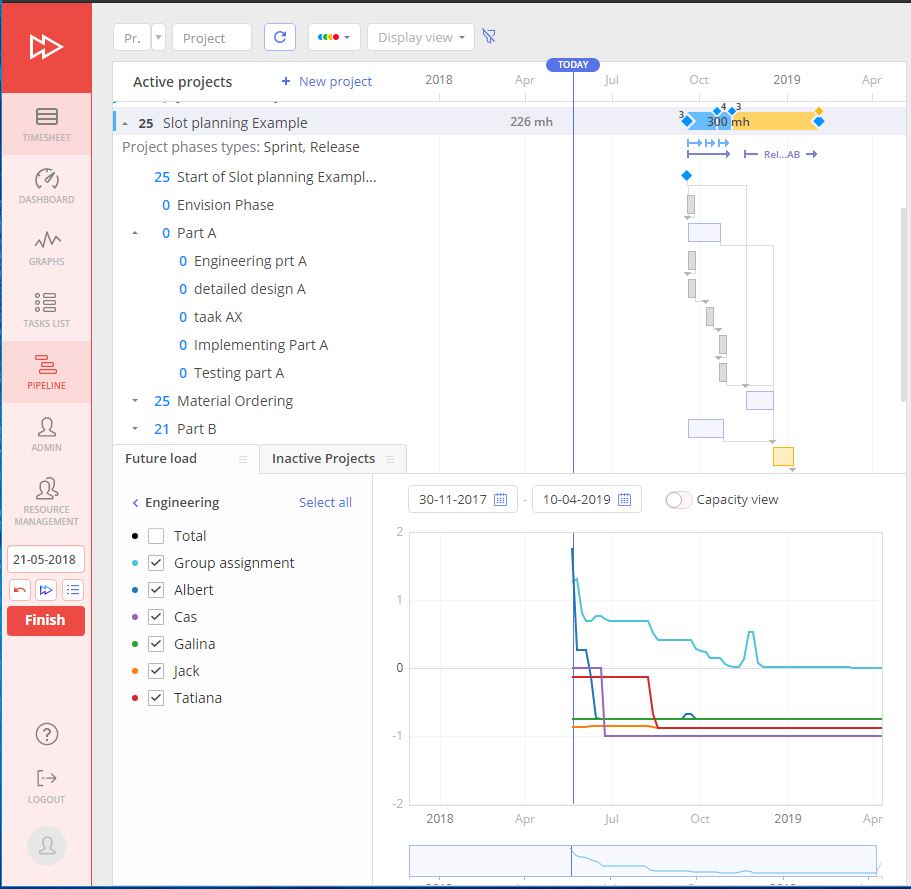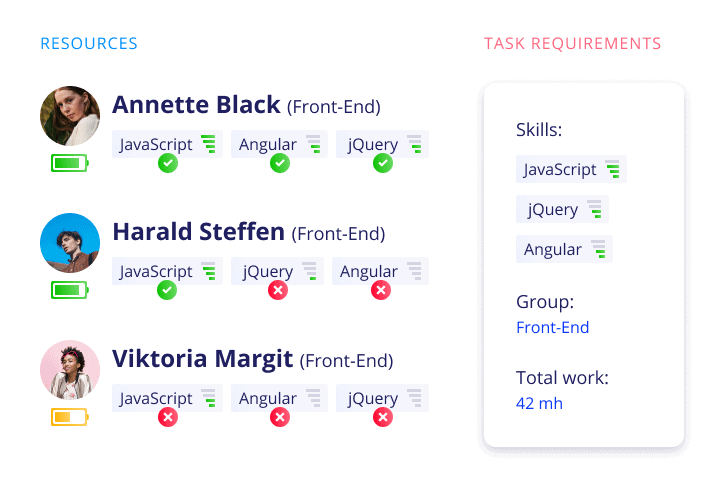Project managers know that putting the right team together is one of the prerequisites for successful project delivery. What can be more effective than assigning the tasks to the right people with the right skills at the right time! However, one of the major challenges that project managers have to deal with is the lack of project resources.
It can be caused by a number of reasons.
- It is a typical problem of fast-developing companies, where the number of projects to work on increases faster than they can hire necessary staff.
- Technologies are developing with breakneck speed, and it takes a while for the existing staff to master them.
- Team members work on multiple projects at the same time and may become overloaded when some additional tasks are assigned to them.
- It may take some time for newcomers to learn the specificity of the work needed to be done, or, being new to the team, they may perform it not so quick as it’s expected of them.
So, in our fast-moving and sometimes unpredictable world, it’s a real challenge for project managers to deliver successful projects when the resources required are limited. According to the survey conducted by the Project Management Institute, talent deficiencies can significantly hamper 40 percent of strategy implementation efforts. Fortunately, this issue can be quite manageable. Read further to find out what actions project managers can take to overcome the staffing issue.
Resource Planning
In relation to project staffing, resource planning aims to make sure that the project is provided with sufficient human resources with corresponding knowledge, skills and experience required for successful completion of the project. Consequently, it’s one of the techniques that can compensate for a lack of human resources.
Pre-planning Activities
Effective resource planning is preceded by two stages: estimating the work needed to be done and creating a schedule, and finding available resources with appropriate skills to get this work done.
To estimate the amount of work to be done, it can be useful to create a work breakdown structure (WBS). WBS is a deliverable-oriented hierarchical structure of the project scope, i.e. the project is divided into deliverables that in turn can be broken down into constituent tasks assigned to available resources. WBS makes it easier to figure out what kinds of teams are required.
After that, you need to estimate the duration of the team’s work on the tasks and schedule resources. Estimating the duration can be not that simple, as you should take into account industry standards for this kind of tasks, previous experience, and find out how much time the team member needs to complete this task. To avoid possible errors in the estimation process, you can apply the critical path method (CPM). According to Project Management Body of Knowledge (PMBOK), “The Critical Path Method is the sequence of scheduled activities that determines the duration of the project.” This method makes it possible to calculate the total estimated time for the project, includes tasks’ dependencies, milestones and duration. Also, you can determine what tasks are critical in the effect on total project time, and how to schedule resources in such a way as to meet the target at minimum cost.
Developing a Resource Management Plan
Effective and detailed resource management plan should include the following information:
- available resources (names of the employees, departments they work for, the team they are currently assigned to);
- the cost of each resource on an hourly basis;
- availability of each resource over the project duration (including planned holidays and contingencies);
- each team member’s responsibilities with their detailed explanation;
- calendar that shows availability of each resource during the week, his/her days off, and planned holidays (this point is optional, but good for illustrative purpose).
One more important point in developing a resource management plan is the assessment of resources availability and their previous performance: you should determine if the team member is available throughout the duration of the project, what projects and tasks they are working on, what skills they have, and how they performed in the previous projects.
Finally, you can assign the tasks to the resource. The following tips can be useful here.
- Take into account the employee’s holidays and days off.
- Group similar tasks together.
- Don’t assign many critical tasks to the same team member.
- If a team member is snowed under, look for other employees with the same skills in other teams.
- Take into account possible contingencies.
How Does Resource Planning Help?
The importance of resource planning cannot be overestimated, as it enables project managers to:
- prevent underutilization – when planning resource availability and performance, you can make sure that the resources are utilized to the full;
- prevent overallocation of resources – due to tracking the availability and utilization rate, the resources’ workload can be balanced;
- minimize the task and resource dependencies – planning the tasks and resource availability demonstrates existing weak points, e.g. an employee who is working on too many tasks at the same time can be reassigned to avoid possible risks.
To sum up, we can say that a thorough resource management plan won’t change the number of available resources, but it will optimize their use to fulfill the project requirements.
What-If Analysis
Basically, what-if analysis shows how the situation will change if certain actions are taken, and therefore, is helpful for making right decisions.
In project management, what-if analysis is used to review and compare various outcomes depending on changing conditions, e.g. changing the dates or amount of resources, hiring new employees, etc. You can predict the difficulties you may face under these modified conditions and understand what measures can be taken to avoid or overcome them, or find better alternatives and come up with a balanced decision. At the initial stages of the project, it allows project managers to optimize their plan and to predict the consequences of any events.
What Are the Advantages of What-If Analysis?
- Possible outcomes evaluation.
What-if analysis shows how a given outcome (e.g. the end date of the project) might be affected by changes in particular variables (e.g. unavailability of key personnel). This provides project managers with greater insight into the possible uncertainties they will probably encounter and the impact of these risks on the successful project completion.
- More reasonable decisions and actions.
Having performed what-if analysis, project managers can develop strategies that minimize the impact of the changes, so they are able to respond to alternative situations more quickly and effectively.
- Better project predictability.
The more variants of situations are played, the more informed becomes the project manager, and the more predictable is the project outcome.
What-If Analysis for Slow Recruitment
When handling the issues of slow recruitment, what-if analysis can come useful, for example, to see what will happen to the project if the tasks are assigned to certain employees, if due to applying resource leveling method the end date is shifted, if a team member is working on multiple tasks at the same time, if something happens to the critical team member, and so on. After considering all possible alternatives, it is much easier to make the right decision.
What-if analysis can be performed by project management software. For example, Epicflow: its What-if analysis creates a temporary copy of your environment with all your resources, projects, tasks, dependencies, and everything else. Entering What-if analysis mode, you can see what will happen on a particular date in future if you add or remove projects; add, remove or reassign resources; create additional tasks.

Thus, if there are problems you’d like to solve but you are not sure about the consequences of your decisions, what-if analysis is the right tool to choose.
Resource Leveling
PMBOK Guide defines resource leveling as “a technique in which start and finish dates are adjusted based on resource constraints with the goal of balancing demand for resources with the available supply.” In simple terms, when available resources are limited, you should adjust the project timeline in accordance with the availability of the critical employee. This technique makes it possible to distribute work between resources in such a way that the project schedule is realistic and achievable and the work environment remains healthy.
Resource Leveling Techniques
There are two resource leveling techniques that can work for slow staffing: Critical Path analysis and Fast-Tracking.
As noted before, Critical Path implies building a sequence of project tasks and stating their interdependencies on each other. After that, you should assess the time required for completing each task and the necessary resources. If they are limited, the start and finish dates of project tasks should be reconsidered if possible.
However, very often, projects have to be delivered on time even when the resources are limited. In this case, Fast-Tracking technique should be applied: interdependent tasks can be executed simultaneously instead of consecutively. Before doing this, project managers should review the tasks in the critical path to find out which of them can be accomplished without following the sequence. You can fast track sequential activities by 33%, i.e. you can start the next activity when the previous is 66% complete. Both activities partially overlap. This technique prevents over-allocation of one resource, and the scheduled resources work in parallel instead.
Advantages of Resource Leveling Technique
Resource leveling enables team members to contribute their attention to high-priority tasks due to adjusting the end dates. Here are some other benefits of applying this technique:
- employees don’t have unrealistic workloads;
- tasks are not assigned to the same people;
- the employees spend most of their time making effective contributions to the project;
- adjusting the project deadline prevents employees’ burnout, so the productivity is improved;
- it demonstrates the “peaks and valleys” of resource utilization in a project.
To sum up, resource leveling enables you to get maximum result of the available human resources and not overload them at the same time.
Skill Management
Skill management is the practice of understanding, developing and deploying the skills possessed by employees. In general, applying skill management technique makes it possible to achieve the following results:
- Discovering skill gaps among the employees and managing them in accordance with a situation;
- Facilitating personnel development;
- Developing employees’ skills and in such a way improving their performance;
- The tasks are assigned to right employees;
- Employees are more productive and fulfill their potential in the most efficient way;
- The team member’s skills are utilized to the advantage of the project.
Let’s consider the example: the company has a content manager who has some graphic design skills. So, he/she can do some content-related design tasks when the members of the design team are snowed under. Alternatively, this content manager can complete the training, improve their design skills and deal with content-related design tasks, while members of the design team will work on other important tasks. In both cases, the company won’t have to hire a freelance designer for that purpose, which saves time, money and effort.
Of course, it’s impossible to bear all the information about employees’ skills in mind. This problem can be successfully solved with project/resource management software. For example, the Competence Management feature by Epicflow makes it possible to add competences to project tasks, change them if necessary and associate with the resources in the system to find a perfect match. You can also see the state of a competence – whether it’s perfectly developed and corresponds to the level required to perform a task (green color), absent (marked with red), insufficiently developed (marked with yellow), or redundant (marked with the blue color, which means that the resource is overskilled). Therefore, the perfect match is marked with green: this is the right resource for completing the task.

One more peculiarity of Epicflow’s Competence Management is a specific option called ‘batteries’. They show a user’s capacity calculated automatically for the dates during which the task should be completed. There are three types of batteries:
- green means that the user has the capacity and can execute the task,
- yellow means that the resource has some capacity but in another group,
- red indicates that the user has no capacity.
Thus, the skill management technique makes it possible to find the right employee and put together the team that will contribute to the project in the most efficient way even when resources are limited.
Read more: Epicflow Summer 2020 Updates: Skill Management, Multigroups, Unit Pool, and More
Are there any proven techniques you would add to the ones listed in the article?

